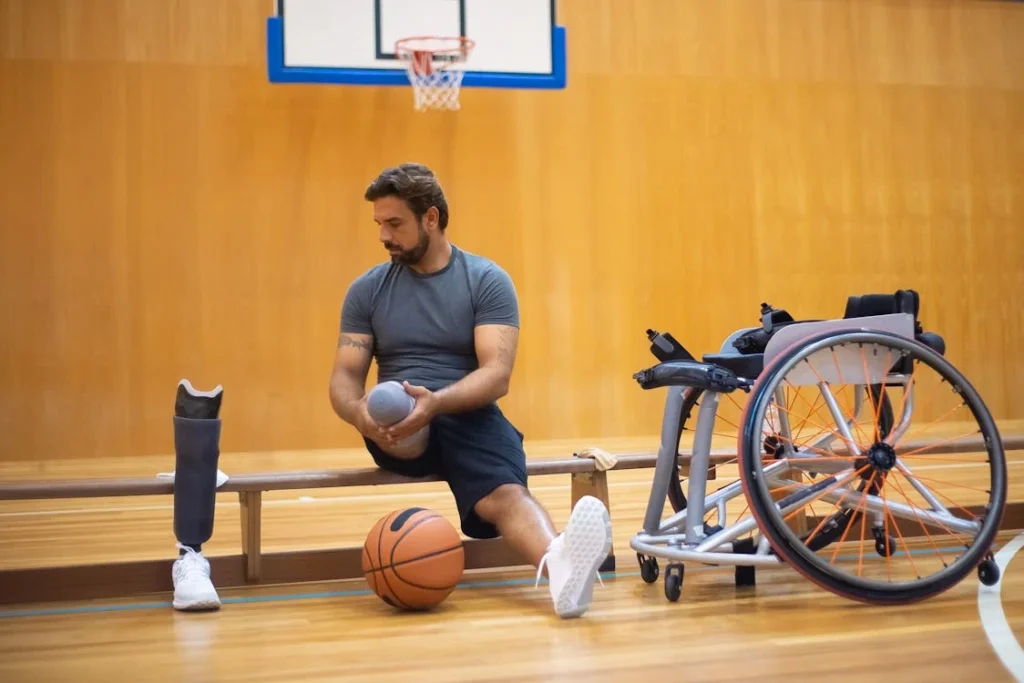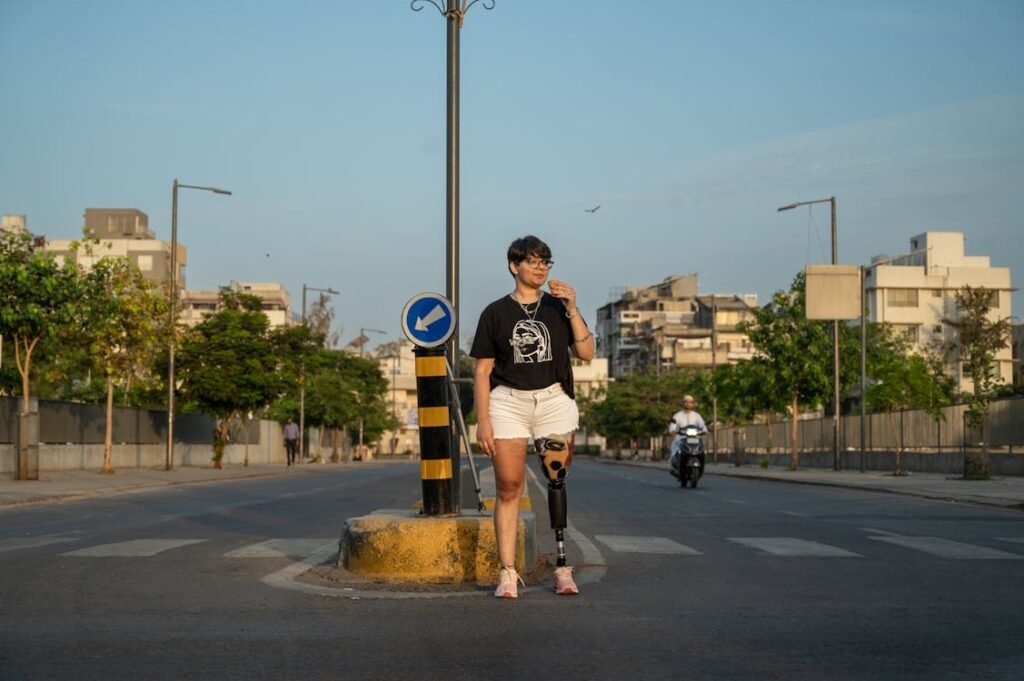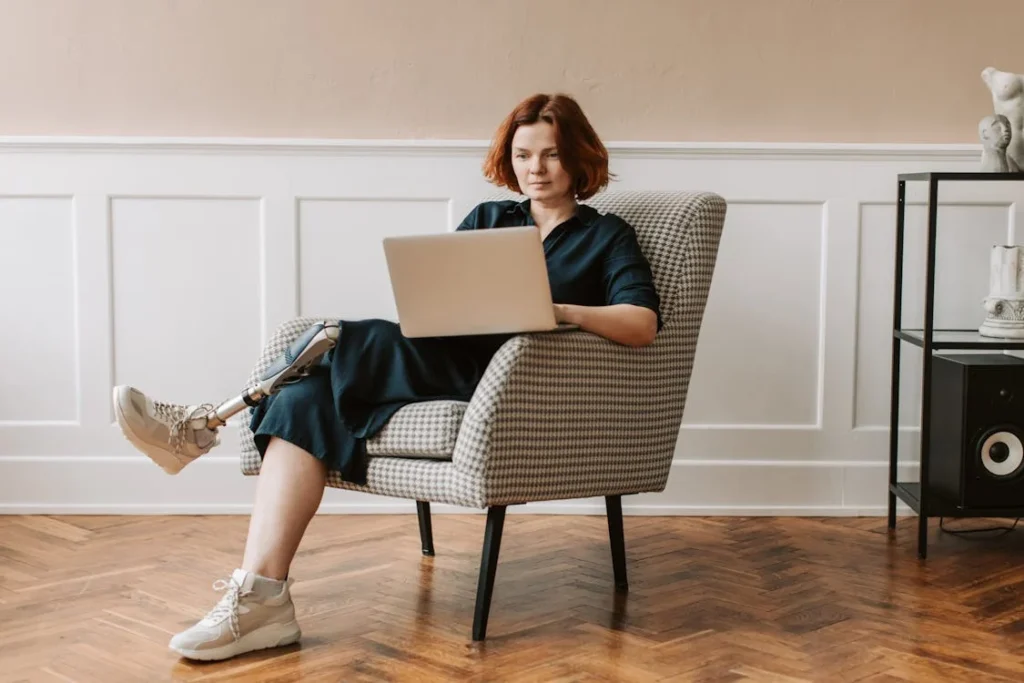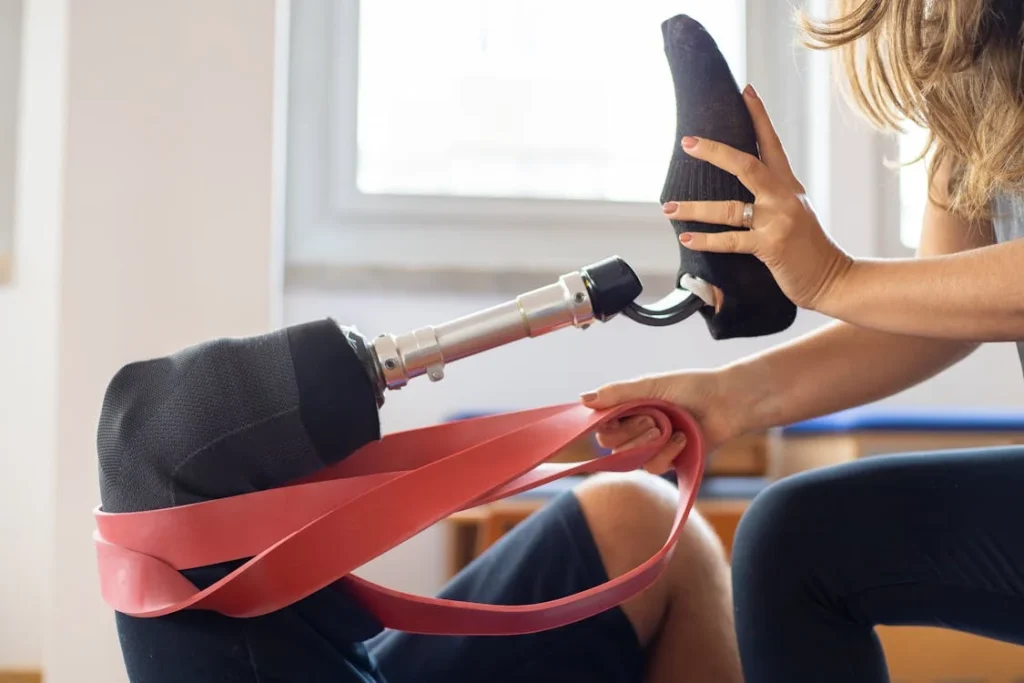Living with an amputation means adapting to a new way of moving, standing, and even sitting. It’s not just about the missing limb—it’s about how your whole body adjusts to that change. For many amputees, one of the biggest challenges that comes after the surgery isn’t always the prosthetic fitting or walking again. It’s the pain that shows up in other places—especially in the back and hips.
This pain doesn’t happen by accident. It’s often caused by how the body carries weight after the limb loss. When the load isn’t shared properly across the body, some muscles and joints have to work harder than they should. Over time, this uneven pressure causes pain and strain in areas like the lower back or the hip on the opposite side of the amputation.
Understanding how load distribution works—and how it can be managed the right way—makes a huge difference. It helps people move better, feel better, and live with more comfort every day. This article will break it all down in clear, simple words. You’ll see why pain happens, how it can be reduced, and what small changes can lead to big relief.

Why Amputees Experience Back and Hip Pain
Your Body Learns to Compensate
When someone loses a limb, especially a leg, their body has to relearn how to move. This includes how they stand, walk, shift weight, and even how they sit.
Normally, our muscles, bones, and joints work together to share the load. But with a missing limb, the balance is thrown off. The body starts to rely more on certain muscles and joints to keep things moving.
That’s where compensation begins. Maybe you lean a little more to one side. Maybe you walk with a limp or slightly twist your upper body without even realizing it.
These small movements add up. Over time, they can strain your spine, tighten your lower back muscles, and put pressure on your hips. That’s when the pain begins.
Poor Load Distribution Means Extra Work
Think of your body like a bridge. If one support beam goes missing, the rest of the bridge has to handle the extra weight.
Without proper distribution, the other parts start to wear down. For amputees, this often means the back muscles and opposite hip are working overtime.
Sometimes the prosthetic itself may not be fitted correctly or might be misaligned, which only makes things worse.
Even tiny misalignments can throw off how your body absorbs shock when you walk or climb stairs. If your gait is uneven, your spine can twist slightly each time you step, leading to chronic lower back pain.
The Role of Muscle Weakness and Imbalance
Another big reason why amputees experience back and hip pain is because of muscle weakness or imbalance.
After an amputation, some muscles aren’t used as much anymore. Others are used more than they should be. This creates an uneven pattern of strength.
Strong muscles in one area and weak ones in another make it hard for the body to stay upright and balanced. The core muscles, including those deep in the back and around the abdomen, might not get the attention they need.
Without their support, the spine loses some of its natural stability. The hips also become less steady, especially when shifting weight from one leg to another.
Daily Habits Can Make It Worse
Sometimes it’s not just about the prosthetic or muscle imbalance. It’s also the everyday choices that pile up.
Sitting too long in one position, standing unevenly, or not moving around enough can all add strain to the lower back and hips.
Amputees may find themselves favoring their sound side during simple tasks—like stepping out of a car or reaching for something.
Over time, this leads to more wear on that side of the body. If that becomes a daily pattern, pain becomes a part of daily life too.

The Science Behind Load Distribution
What Load Distribution Really Means
Load distribution is a simple idea—it’s all about how your body spreads weight and pressure when you move, stand, or sit.
For a person with both limbs, the weight is divided evenly. But for someone who uses a prosthetic, especially for a leg, that balance changes. One side often ends up carrying more than its fair share.
When load distribution is uneven, the forces that run through your bones and joints are not where they should be. The spine may curve slightly. One hip might stay higher or lower than the other. Your shoulders might lean.
Over time, these tiny changes start to affect how your muscles work. Some tighten up, others weaken. This can make daily movements harder and more painful.
The Connection Between the Spine, Pelvis, and Hips
Everything in your body is connected. The spine doesn’t work alone—it’s supported by the pelvis and hips. When one part is off, it affects the others.
If your prosthetic leg doesn’t match the height or angle of your natural leg, the pelvis might tilt. That tilt puts pressure on the lower spine. It may not hurt at first, but the longer it stays that way, the more stress it creates.
Your hips are also important here. They act like the base of your movement system. If one hip is doing more work than the other, or if it’s not moving the way it should, that can ripple up into the back.
Some people start feeling pain deep in their hip joint. Others feel it as tightness across the lower back. It all depends on how their body is handling the extra load.
Prosthetic Alignment Plays a Big Role
A well-aligned prosthetic can make a huge difference. It should support your natural posture and help you move evenly.
But if it’s even a little off—too short, too long, or at the wrong angle—your body starts adjusting to that mistake.
This might mean putting more pressure on the sound limb or overusing muscles around the lower back to keep balance.
Some people shift their weight forward. Others twist their shoulders when walking. All of these movements change how the load moves through the body, and that’s when the pain starts creeping in.
A good prosthetist doesn’t just fit a device—they study how you walk, how you stand, and how your whole body moves.
They adjust things slowly, making sure the load is shared correctly. That’s what keeps you moving safely and with less pain.
Small Misalignments, Big Effects
It doesn’t take a huge problem to cause pain. Even a slight tilt in your pelvis or a half-inch difference in leg length can create tension in your lower back.
Your body has to work harder to stay upright. Over time, the extra effort becomes fatigue, and fatigue turns into pain.
Many people don’t notice these changes at first. They feel fine when they take short walks or rest often. But over time—especially with longer walks, standing jobs, or uneven ground—the signs become clear.
Back pain, hip soreness, and stiffness start to show up more often and last longer.

How to Improve Load Distribution for Pain Relief
It Starts with the Right Prosthetic Fit
A comfortable, well-aligned prosthetic is the foundation. It’s not just about making sure it stays on or looks right—it has to match your body’s natural length and angle.
That means paying close attention to how the foot strikes the ground, how your hips move, and how your spine holds up when you walk.
If your prosthetic is too short, your body leans to one side. If it’s too long, your hip may hike up on every step. Neither is good.
Over time, these small imbalances lead to big discomfort. That’s why regular check-ins with a prosthetist matter. Your body changes over time, and your prosthetic needs to change with it.
Even if you’ve been using your device for a while and it feels “fine,” there might be room for improvement. A small adjustment could mean a big step toward pain relief.
Strengthening the Right Muscles Makes a Difference
Muscle support is key. Especially the core—the deep muscles around your stomach and back that hold you upright.
These muscles act like a belt that keeps your spine stable. If they’re weak, your back has to do more work, and that’s where the pain begins.
It’s also important to keep both legs strong, even if one is a prosthetic. The muscles around your residual limb still need care. And on your sound side, strength keeps the joints from wearing out too soon.
Hips need to move freely. Knees should be able to bend without strain. And your lower back needs to feel supported.
Exercises don’t need to be hard. They just need to be consistent. Simple routines like gentle stretches, seated leg lifts, or lying on your back and tightening your stomach muscles can help a lot.
It’s about building stability so your body doesn’t have to fight for balance with every step.
Posture Isn’t Just About Standing Tall
Posture affects everything. It’s how your body lines up when you’re still, and how it holds together when you’re moving.
If your head leans forward or your shoulders round too much, the weight shifts away from your center. That puts more strain on your spine and hips.
Amputees often develop habits over time—leaning to the side, tilting the pelvis, or standing more on one leg than the other.
These are understandable adjustments, but they change the body’s alignment. The trick is to become aware of them and gently correct them when possible.
That might mean practicing standing in front of a mirror to check your balance. Or working with a physiotherapist who can spot what’s off and guide you through new movements.
You don’t need perfect posture—you just need a balance that your body can maintain without pain.
Movement Patterns Need to Be Relearned
The way you walk matters more than most people think. Gait training helps your body move evenly and smoothly. After an amputation, it’s common to develop new ways of walking.
Sometimes, those ways aren’t ideal. They help you get from place to place, but they may be loading one side of the body more than the other.
Learning how to walk again, with a trained eye watching your every step, can take away a lot of that uneven pressure.
Gait therapists look at everything—from foot placement to how your arms swing. They help retrain your body to move in ways that spread the load better, reduce strain, and prevent pain.
This is especially helpful if you’ve been walking with a limp, leaning forward, or turning your foot slightly when you step. Small corrections in gait can lead to big changes in comfort.

The Role of Daily Habits in Load Balance
How You Sit and Stand Shapes Your Pain
Most people don’t think about how they sit or stand. But for amputees, these small habits can have a big effect. If you tend to lean to one side while sitting, your spine starts to adjust to that curve.
Over time, this turns into stiffness, soreness, or sharp pain in the lower back or hip.
Even something as simple as standing for long periods with your weight more on one leg than the other adds stress to your joints. When you repeat that day after day, it builds up tension in the hips, knees, and spine.
The key is awareness. Try to notice how your body rests. Are you always shifting to the same side? Are your shoulders level when you stand?
Catching these patterns early helps prevent long-term issues. It’s not about being perfect. It’s about gentle corrections and making small changes throughout the day.
Sleeping Positions Can Make or Break Comfort
You spend several hours every night in the same position. That’s a long time for your body to be in one posture. If your sleeping position twists your hips or puts uneven pressure on your spine, you may wake up sore or stiff.
Some amputees find relief by placing a pillow between their knees or under their lower back to support the spine.
Others sleep better on their side with the sound leg slightly bent. It depends on your body, your prosthetic, and what makes you feel supported.
A supportive mattress and pillow help too. They should keep your spine in a neutral position, not too curved and not too flat. Good sleep posture helps your muscles relax fully and recover from the day’s activity.
Footwear and Flooring Matter More Than You Think
What’s under your feet plays a bigger role than most people realize.
Shoes that don’t support your arch or cushion your steps can send shockwaves up your legs and into your spine. Hard floors with no padding make this even worse.
For amputees, it’s especially important to wear shoes that help maintain even balance. Your prosthetic foot already handles movement differently, so you want shoes that support the rest of your body’s effort to stay level.
Try to avoid worn-out soles or mismatched heights between shoes and your prosthetic foot.
And when possible, walk on softer surfaces like carpets, yoga mats, or padded flooring if you’re doing rehab exercises. These reduce the impact on your joints and encourage smoother movement.
Mindful Movement Makes a Big Difference
Being mindful means noticing how your body feels as you move. It’s about checking in with your balance, your posture, and your comfort—not just when pain appears, but all the time.
That kind of body awareness helps you adjust before problems start.
Take time each day to slow down and feel your movements. How does your back feel after a walk? Do your hips ache after sitting too long? These signals aren’t just background noise—they’re your body’s way of asking for help.
You don’t need to fix everything at once. Just start by tuning in. Maybe it’s adjusting how you sit in your chair.
Maybe it’s stretching before you get out of bed. These small, mindful moments teach your body new habits that protect it from pain.

Rehabilitation Strategies That Support Better Load Distribution
Why Rehab Is More Than Just Exercise
Rehabilitation isn’t just about getting stronger or walking further. It’s about teaching your body to move in smarter ways. After an amputation, your muscles, joints, and nervous system all need to learn new patterns. That’s not something that happens overnight.
Good rehab focuses on balance, posture, and smooth, pain-free movement. It helps you avoid habits that might feel easier in the short term but cause long-term harm. You learn to shift weight evenly.
You practice standing tall. You build strength not just in the legs, but in your core, your back, and even your shoulders. Everything works together.
Rehab also includes rest and recovery. If your muscles don’t get a break, they can’t rebuild. That’s why the best rehabilitation plans mix activity with downtime and focus on slow, steady progress.
The Power of Guided Movement
Working with a trained therapist can make a world of difference. They know what to look for. They can spot small movements that feel fine to you but are causing uneven load on your joints.
They might notice that your pelvis drops slightly on one side when you walk, or that your back arches a bit too much when you stand.
These are small things—but they matter.
Through guided exercises and gentle corrections, you start to train your muscles and joints to work together again. This can mean less strain on your back, more freedom in your hips, and a smoother, more balanced gait.
The therapist might use mirrors, videos, or pressure sensors to help you see your movement clearly. That visual feedback helps you connect how your body feels to how it moves. The more you practice, the more natural those new patterns become.
Home-Based Recovery That Fits Your Life
Not everyone can get to a clinic regularly. That’s where home-based rehab comes in. With a bit of space, a clear plan, and the right tools, you can keep making progress every day—even from your living room.
Gamified rehabilitation tools are a new and fun way to do this. They make exercise feel more like play, keeping you engaged and motivated.
These systems often track your movement, give you feedback, and adjust the difficulty as you improve.
It’s not just about staying active. It’s about staying active in the right way—doing movements that build strength, improve alignment, and teach your body to handle load better.
Having a set routine, even just 15–20 minutes a day, can bring big changes over time. What matters most is being consistent. Small, steady improvements are what lead to lasting comfort and freedom.
Listening to Your Body During Recovery
Pain is a signal, not a punishment. If your back starts to ache or your hips feel tight, it means something needs attention.
That might be a posture shift, a new stretch, or even just a bit more rest. Ignoring these signs only lets the problem grow.
During rehab, you’ll learn to listen to your body more closely. Some days, you’ll feel strong and ready. Other days, you might need to go slower. Both are okay. What matters is paying attention and working with your body, not against it.
Good rehab is flexible. It adjusts to your needs. It respects the effort your body is making to adapt, and it gives you tools to make that adaptation easier and safer.

Long-Term Strategies for Pain-Free Movement
Staying Ahead of Pain with Regular Check-Ins
One of the best ways to prevent back and hip pain before it starts—or before it gets worse—is through regular check-ins.
These don’t have to be full hospital visits. Sometimes, just spending time with your prosthetist or physiotherapist every few months is enough.
As your body changes, your prosthetic might need to change with it. Maybe your muscles are stronger now. Maybe your posture has shifted. Maybe your walking pattern has evolved.
These updates are good—they show progress—but they also mean your device may need a small adjustment to keep up.
Checking in regularly allows professionals to catch small problems early, before they become painful.
A tiny change in height, a new type of liner, or even a different walking shoe can make a big difference in how your body handles pressure and balance.
The Importance of Staying Active
Movement is medicine. When we don’t move enough, muscles get tight, joints get stiff, and the body starts to forget how to stay balanced.
For amputees, this can happen quickly, especially if pain or fear of falling gets in the way of staying active.
But staying active doesn’t have to mean intense workouts or long walks. It can mean stretching in the morning, taking short strolls during the day, or doing a bit of gentle yoga before bed. What matters most is keeping the body in motion.
Activity keeps muscles awake and joints moving freely. It also helps you notice when something doesn’t feel right—before it turns into full-blown pain.
The more your body stays in motion, the better it gets at sharing load evenly across your spine, hips, and legs.
Building Better Body Awareness
Body awareness means paying attention to how you move and how you feel. For amputees, this can be one of the most powerful tools in preventing pain.
The more you understand how your body responds to different movements, the more you can make choices that support it.
Do you feel off-balance after standing on a hard floor? Do certain shoes make your hip ache more? Does your back feel better after stretching or worse after sitting too long? These little clues tell you what your body needs.
By tuning into these details, you can make better choices—about posture, shoes, activity, or even rest. You become your own guide, helping your body stay aligned and balanced.
Some people keep a simple journal where they note pain levels, activity, and anything that felt different that day. Over time, patterns emerge. And those patterns help shape smarter routines.
Surrounding Yourself with the Right Support
Pain can feel isolating. But you don’t have to manage it alone. Having a team—whether it’s a prosthetist, physiotherapist, peer support group, or even a family member—can make a huge difference.
These people help you stay focused, stay informed, and stay hopeful.
Even small conversations, like sharing what’s working for you or hearing what’s worked for someone else, can spark new ideas.
You may learn a better way to stretch, a new trick to adjust your posture, or a brand of shoes that’s helped someone else with the same issue.
Being surrounded by the right support means you have people to lean on when you need help and people to celebrate with when you feel progress. And that kind of emotional balance plays a big part in physical comfort too.
Conclusion
Living with limb loss doesn’t have to mean living with constant back or hip pain. When your body is supported through proper load distribution, everything works more smoothly—from your spine to your stride. It’s not about perfection; it’s about balance, awareness, and support.
Small changes make big differences. A well-fitted prosthetic, mindful movement, regular rehab, and listening to your body can all help reduce pain and improve your daily life. With the right strategies, you can move more freely, rest more comfortably, and feel more in control of your body.
Pain is not something you have to accept. It’s a signal that your body needs care, and you have the tools to respond. Take it one step at a time, stay consistent, and don’t be afraid to ask for help. Your comfort is worth the effort.



